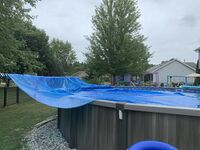m (Added a new title) |
m (Moved and Resized Photo) |
||
| (One intermediate revision by the same user not shown) | |||
| Line 1: | Line 1: | ||
| − | |||
==Does pool water get warmer on a sunny day with the solar cover on or off?== | ==Does pool water get warmer on a sunny day with the solar cover on or off?== | ||
| Line 7: | Line 6: | ||
==What is the best color for a solar pool cover== | ==What is the best color for a solar pool cover== | ||
| − | The color of the solar cover can in fact make a notable difference. Below is a list of a few of the most commonly seen colors sold on the market today. | + | [[File:solar_covered_pool.jpeg|200px|thumb|Solar Cover over an Above Ground Pool]]The color of the solar cover can in fact make a notable difference. Below is a list of a few of the most commonly seen colors sold on the market today. |
*Clear bubble-type cover -- passes through the most sunlight, retains heat well | *Clear bubble-type cover -- passes through the most sunlight, retains heat well | ||
Latest revision as of 16:55, 13 September 2020
Does pool water get warmer on a sunny day with the solar cover on or off?
With no wind and relatively high humidity, you will get more heat when the pool is in the sun with the cover off. The covers generally are more for maintaining heat by reducing heat loss through evaporation/radiation ... solar cover is a really bad name for them.[1]
It depends on the clarity of the cover. If it's a very clear cover, it will let a significant amount of sunlight through, both visible and some infrared and some UV. Such covers do truly aid heating of the pool during the day. For an opaque cover, if it's white or reflective then there will be little heating of the water, but if it's a dark opaque cover then there will be some heat transfer for thin covers such as electric safety covers. For bubble-type covers, there won't be much sunlight absorption and heat transfer unless the top part of the cover is clear and only the bottom part touching the water is black or dark.
What is the best color for a solar pool cover
The color of the solar cover can in fact make a notable difference. Below is a list of a few of the most commonly seen colors sold on the market today.
- Clear bubble-type cover -- passes through the most sunlight, retains heat well
- Clear-on-top, dark-on-bottom, bubble-type cover -- dark bottom heats up from sunlight and passes heat to the water, retains heat well
- Dark opaque thin cover -- dark cover absorbs heat and passes it to the water, but the thin cover doesn't retain as much heat
- White or reflective bubble-type cover -- does not absorb heat but retains heat well
- White or reflective thin cover -- does not absorb heat and the thin cover doesn't retain as much heat
The main trade-off is that the clear covers also pass through UV so while you get heating from sunlight passing through, you also get breakdown of chlorine.
With no cover at all, there is substantial absorption of sunlight which heats the pool where a white plaster pool with 4.5 foot average depth absorbs 60% of the sun's light energy and heats the pool at around 0.7ºF per hour with noontime sun. Competing with this is water evaporation where the same pool would lose about 5ºF if 1/4" of water evaporated. Evaporation depends not only on the water and air temperature (except for perfectly dry air), but also depends on the humidity and especially on wind at the pool water's surface. See the thread Water Absorption and Heating from Sunlight for more technical details.
Heat Loss Through Evaporation
Though the rate of evaporation varies a lot[2] a not atypical high evaporation rate of 1/4" per day is a volume of water over a square meter of surface area of 0.00635 cubic meters or 6350 ml. The heat of evaporation is 2428 J/g (at 30ºC or 86ºF) or about 2428 J/ml. So that's 2428*6350 = 15,417,800 Joules or 4.3 kWh loss per day per square meter.
Given that over that same square meter during peak noontime sun is 1 kW, this means that high evaporation counteracts about 4.3 hours of peak noontime sun. So, 1/4" of evaporation will lower a 4.5 foot average pool depth temp by 4.9ºF. This the solar insolation (solar energy at the surface of the Earth) per area of flat horizontal surface in a place like Arizona, the peak in July is around 7.8 kWh/m2/d (5.3ºF temp rise in white plaster pool) while in New York in June it's around 5.7 kWh/m2/d (3.9ºF temp rise in white plaster pool).
So even with evaporation there may be a net gain during the day, but there is significant loss at night from convection in addition to evaporation. Evaporation is greatest when the humidity is low and is lowest when the humidity is high. However, it is also a function of temperature with the net result being that the evaporation rate is roughly the same during the day and at night since the higher relative humidity at night is offset by the lower temperature (i.e. the partial vapor pressure is roughly the same in both cases).
Studies described here indicate that heat loss is 56% by evaporation, 26% by radiation, and 18% by convection.


